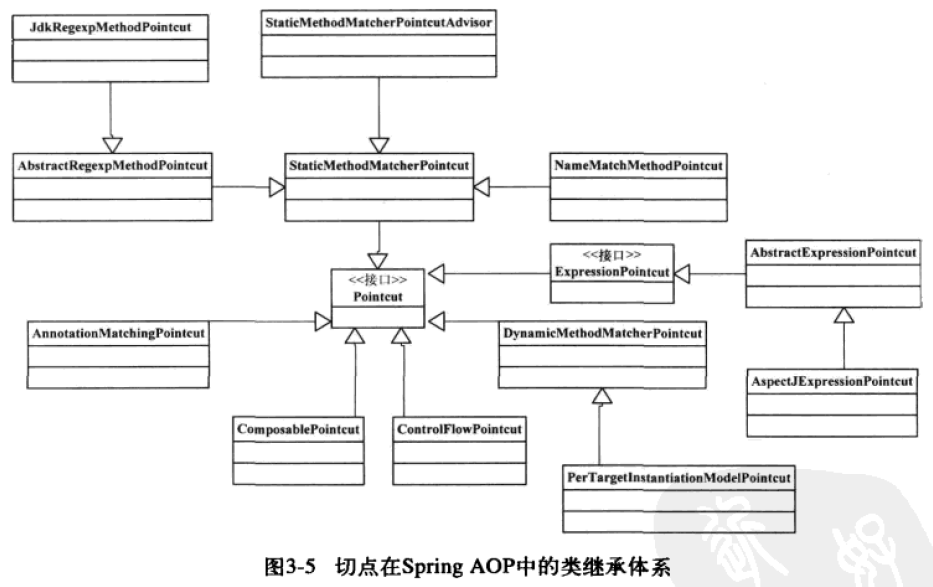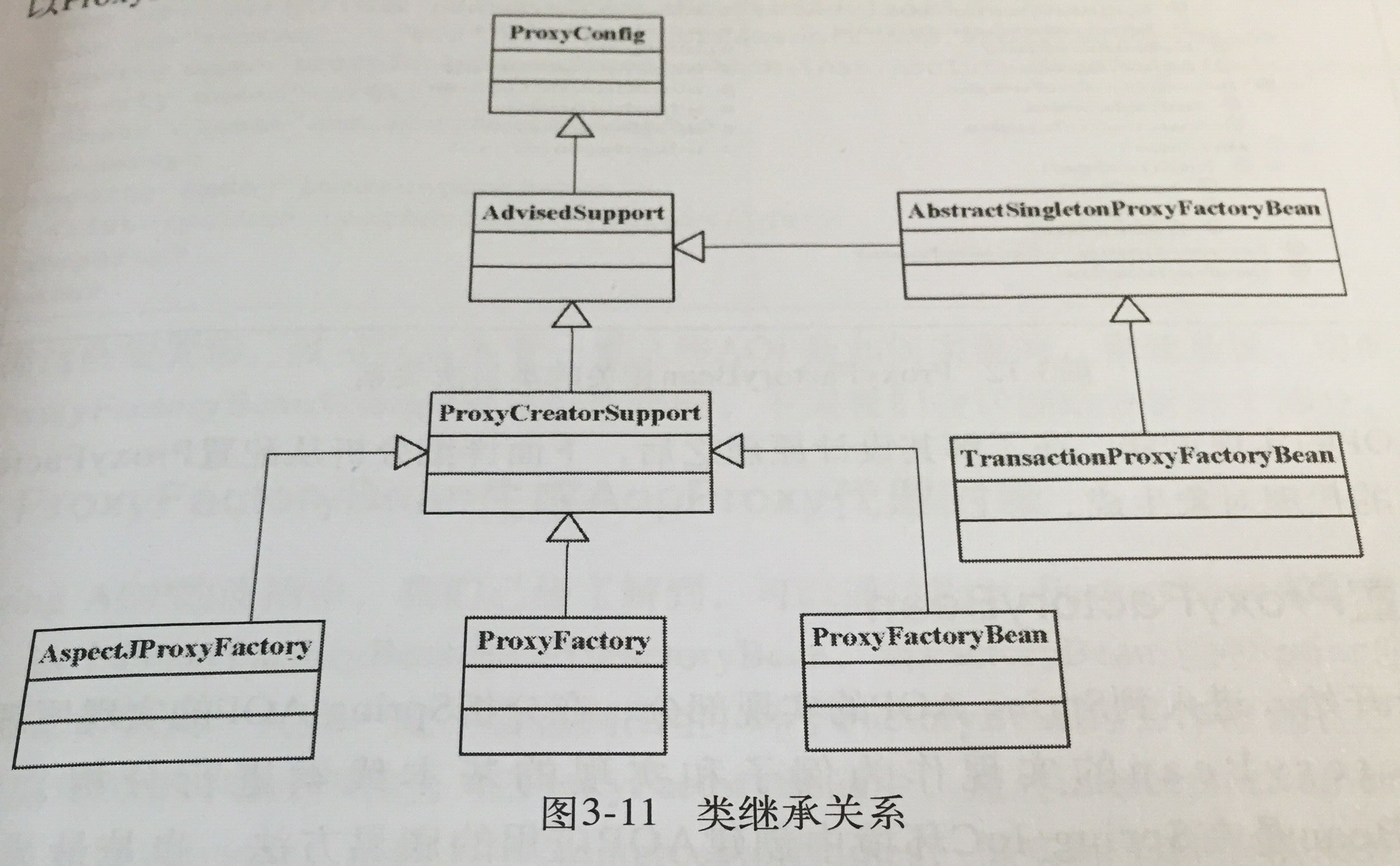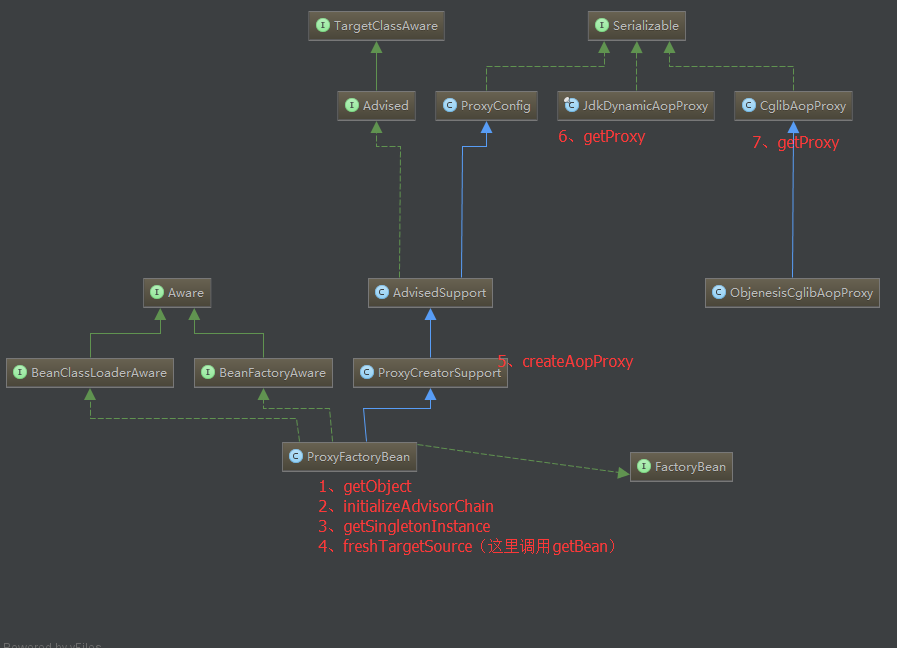Spring AOP原始碼分析(生成代理物件)
AOP基本概述
Advice(通知)
BeforeAdvice
package org.springframework.aop;
import java.lang.reflect.Method;
public interface MethodBeforeAdvice extends BeforeAdvice {
void before(Method method, Object[] args, Object target) throws Throwable;
}before是回撥方法,在Advice中配置了目標方法後,會在呼叫目標方法時被回撥。
引數:
method:目標方法
args:目標方法的輸入引數
target:目標物件
AfterReturningAdvice
package org.springframework.aop;
import java.lang.reflect.Method;
public interface AfterReturningAdvice extends AfterAdvice {
void afterReturning(Object returnValue, Method method, Object[] args, Object target) throws Throwable;
}在目標方法呼叫結束並正常返回時,介面被回撥
ThrowsAdvice
public interface ThrowsAdvice extends AfterAdvice {
}丟擲異常時被回撥,AOP使用反射實現(方法名叫AfterThrowing?)
PointCut(切入點)
public interface Pointcut {
ClassFilter getClassFilter();
MethodMatcher getMethodMatcher();
Pointcut TRUE = TruePointcut.INSTANCE;
}PointCut是通過MethodMatcher 進行切入點方法匹配的,判斷是否需要對當前方法進行增強處理。
通過JdkRegexpMethodPointcut理解MethodMatcher:
在JdkRegexpMethodPointcut的基類StaticMethodMatcherPointcut中設定MethodMatcher為StaticMethodMatcherPointcut(StaticMethodMatcher)
public abstract class StaticMethodMatcherPointcut extends StaticMethodMatcher implements Pointcut {
@Override
public final MethodMatcher getMethodMatcher() {
return this;
}
}在JdkRegexpMethodPointcut中通過正則表示式匹配需要增強的方法:
protected boolean matches(String pattern, int patternIndex) {
Matcher matcher = this.compiledPatterns[patternIndex].matcher(pattern);
return matcher.matches();
}在NameMatchMethodPointcut中通過方法名進行方法的匹配:
@Override
public boolean matches(Method method, Class<?> targetClass) {
for (String mappedName : this.mappedNames) {
if (mappedName.equals(method.getName()) || isMatch(method.getName(), mappedName)) {
return true;
}
}
return false;
}
protected boolean isMatch(String methodName, String mappedName) {
return PatternMatchUtils.simpleMatch(mappedName, methodName);
}Advisor(通知器)
通知器負責把切入點和增強處理接合起來。
在切點處決定使用哪個通知
AOP設計與實現
JVM動態代理
JDK和CGLIB都是用動態代理實現的
AopProxy代理物件
Spring中,是通過ProxyFactoryBean來完成代理物件的生成的
ProxyConfig
資料基類,為ProxyFactoryBean這樣的子類提供配置屬性。
AdvisedSupport
AOP對通知和通知器的操作,對不同的AOP代理的生成都是一樣的。對於具體生代理類,由AdvisedSupport的子類來做。
ProxyCreatorSupport
子類建立AOP代理類的輔助
ProxyFactoryBean
IOC容器中宣告式配置,生成代理類
ProxyFactory
程式設計式使用,生成代理類
AspectJProxyFactory
需要使用AspectJ功能的AOP應用,這個起到整合Spring和AspectJ的作用
具體AOP代理物件的生成是由ProxyFactoryBean、ProxyFactory、AspectJProxyFactory完成的。
如何配置ProxyFactory?
<bean id="testAdvisor" class="com.abc.TestAdvisor" />
<!-- 通知器,實現了目標物件需要增強的切面行為,也就是通知 -->
<!-- 這裡我理解的是被代理的bean的scope如果是prototype,那麼這個代理Bean就是prototype -->
<bean id="testAop" class="org.springframework.aop.ProxyFactoryBean">
<property name="proxyInterfaces">
<value>com.test.AbcInterface</value>
</property>
<property name="target">
<!-- 目標物件 -->
<bean class="com.abc.TestTarget" />
</property>
<property name="interceptorNames">
<!-- 需要攔截的方法介面,通知器 -->
<list>
<value>
testAdvisor
</value>
</list>
</property>
</bean>代理物件生成過程總覽
以singleTon為例:
代理物件獲取入口:
ProxyFactoryBean的getObject
AopProxy生成過程:
ProxyFactoryBean的getObject獲取代理物件
@Override
public Object getObject() throws BeansException {
//初始化通知器鏈,為代理物件配置通知器鏈。
initializeAdvisorChain();
//區分SingleTon和ProtoType,生成對應的Proxy
if (isSingleton()) {
// 只有SingleTon的Bean才會一開始就初始化,ProtoType的只有在請求的時候才會初始化,代理也一樣
return getSingletonInstance();
} else {
if (this.targetName == null) {
logger.warn("Using non-singleton proxies with singleton targets is often undesirable. " +
"Enable prototype proxies by setting the 'targetName' property.");
}
return newPrototypeInstance();
}
}關於initializeAdvisorChain
ProxyFactoryBean的initializeAdvisorChain
這個初始化過程有一個標誌位advisorChainInitialized,這個標誌用來表示通知器鏈是否已經初始化。
這個就是通知器鏈,在AdvisorSupport中:
private List<Advisor> advisors = new LinkedList<Advisor>();如果已經初始化,那麼這裡不會再初始化,直接返回。初始化只是在應用第一次通過ProxyFactoryBean獲取代理物件的時候。
完成這個初始化之後,接著會讀取配置中出現的所有通知器(把通知器的名字交給容器的getBean,IOC容器的回撥獲取通知器),把通知器加入攔截器鏈(addAdvisoronChainCreation實現)。
private synchronized void initializeAdvisorChain() throws AopConfigException, BeansException {
if (this.advisorChainInitialized) {
return;
}
if (!ObjectUtils.isEmpty(this.interceptorNames)) {
if (this.beanFactory == null) {
throw new IllegalStateException("No BeanFactory available anymore (probably due to serialization) " +
"- cannot resolve interceptor names " + Arrays.asList(this.interceptorNames));
}
// Globals can't be last unless we specified a targetSource using the property...
if (this.interceptorNames[this.interceptorNames.length - 1].endsWith(GLOBAL_SUFFIX) &&
this.targetName == null && this.targetSource == EMPTY_TARGET_SOURCE) {
throw new AopConfigException("Target required after globals");
}
// Materialize interceptor chain from bean names.
for (String name : this.interceptorNames) {
if (logger.isTraceEnabled()) {
logger.trace("Configuring advisor or advice '" + name + "'");
}
if (name.endsWith(GLOBAL_SUFFIX)) {
if (!(this.beanFactory instanceof ListableBeanFactory)) {
throw new AopConfigException(
"Can only use global advisors or interceptors with a ListableBeanFactory");
}
addGlobalAdvisor((ListableBeanFactory) this.beanFactory,
name.substring(0, name.length() - GLOBAL_SUFFIX.length()));
}
else {
// If we get here, we need to add a named interceptor.
// We must check if it's a singleton or prototype.
Object advice;
if (this.singleton || this.beanFactory.isSingleton(name)) {
// Add the real Advisor/Advice to the chain.
advice = this.beanFactory.getBean(name);
}
else {
// It's a prototype Advice or Advisor: replace with a prototype.
// Avoid unnecessary creation of prototype bean just for advisor chain initialization.
advice = new PrototypePlaceholderAdvisor(name);
}
addAdvisorOnChainCreation(advice, name);
}
}
}
this.advisorChainInitialized = true;
}生成單件代理物件
ProxyFactoryBean的getSingletonInstance
private synchronized Object getSingletonInstance() {
if (this.singletonInstance == null) {
//這裡會呼叫getBean,獲取被代理物件
this.targetSource = freshTargetSource();
if (this.autodetectInterfaces && getProxiedInterfaces().length == 0 && !isProxyTargetClass()) {
// 根據 AOP 框架判斷需要代理的介面
Class<?> targetClass = getTargetClass();
if (targetClass == null) {
throw new FactoryBeanNotInitializedException("Cannot determine target class for proxy");
}
//這裡是設定代理物件的介面
setInterfaces(ClassUtils.getAllInterfacesForClass(targetClass, this.proxyClassLoader));
}
// Initialize the shared singleton instance.
super.setFrozen(this.freezeProxy);
//這裡方法會使用ProxyFactory生成需要的Proxy
this.singletonInstance = getProxy(createAopProxy());
}
return this.singletonInstance;
}
//通過createAopProxy返回的AopProxy來得到代理物件
protected Object getProxy(AopProxy aopProxy) {
return aopProxy.getProxy(this.proxyClassLoader);
}ProxyFactoryBean的freshTargetSource
private TargetSource freshTargetSource() {
if (this.targetName == null) {
if (logger.isTraceEnabled()) {
logger.trace("Not refreshing target: Bean name not specified in 'interceptorNames'.");
}
return this.targetSource;
}
else {
if (this.beanFactory == null) {
throw new IllegalStateException("No BeanFactory available anymore (probably due to serialization) " +
"- cannot resolve target with name '" + this.targetName + "'");
}
if (logger.isDebugEnabled()) {
logger.debug("Refreshing target with name '" + this.targetName + "'");
}
Object target = this.beanFactory.getBean(this.targetName);
return (target instanceof TargetSource ? (TargetSource) target : new SingletonTargetSource(target));
}
}具體代理物件的生成,是在ProxyFactoryBean的基類AdvisedSupport的實現中藉助AopProxyFactory完成。
在ProxyCreatorSupport中,AopProxy是通過AopProxyFactory生成的,需要生成的代理物件資訊封裝在AdvisedSupport中,這個物件也是createAopProxy的輸入引數(this):
ProxyCreatorSupport的createAopProxy
protected final synchronized AopProxy createAopProxy() {
if (!this.active) {
activate();
}
//通過AopProxyFactory取得AopProxy,AopProxyFactory是在初始化函式中定義的,使用的是DefaultAopProxyFactory
return getAopProxyFactory().createAopProxy(this);
}現在問題轉換為DefaultAopProxyFactory如何生成AopProxy了,這裡有兩種方式,JdkDynamicAopProxy和CglibProxyFactory
DefaultAopProxyFactory的createAopProxy
public class DefaultAopProxyFactory implements AopProxyFactory, Serializable {
@Override
public AopProxy createAopProxy(AdvisedSupport config) throws AopConfigException {
if (config.isOptimize() || config.isProxyTargetClass() || hasNoUserSuppliedProxyInterfaces(config)) {
//獲取配置的目標物件
Class<?> targetClass = config.getTargetClass();
if (targetClass == null) {
//如果沒有目標物件,丟擲異常,提醒AOP應用提供正確的目標配置
throw new AopConfigException("TargetSource cannot determine target class: " +
"Either an interface or a target is required for proxy creation.");
}
if (targetClass.isInterface() || Proxy.isProxyClass(targetClass)) {
return new JdkDynamicAopProxy(config);
}
//由於CGLIB是一個第三方類庫,所以需要在CLASSPATH中配置
return new ObjenesisCglibAopProxy(config);
}
else {
return new JdkDynamicAopProxy(config);
}
}
}JdkDynamicAopProxy 生成AopProxy代理物件:
final class JdkDynamicAopProxy implements AopProxy, InvocationHandler, Serializable {
@Override
public Object getProxy(ClassLoader classLoader) {
if (logger.isDebugEnabled()) {
logger.debug("Creating JDK dynamic proxy: target source is " + this.advised.getTargetSource());
}
//獲取代理物件配置,主要是介面
Class<?>[] proxiedInterfaces = AopProxyUtils.completeProxiedInterfaces(this.advised);
//JdkDynamicAopProxy 需要實現InvocationHandler這裡才能傳this
findDefinedEqualsAndHashCodeMethods(proxiedInterfaces);
return Proxy.newProxyInstance(classLoader, proxiedInterfaces, this);
}
@Override
public Object invoke(Object proxy, Method method, Object[] args) throws Throwable {
//...代理的回撥方法,invoke
//也可以理解為攔截方法
}
}CglibAopProxy生成AopProxy代理物件:
@Override
public Object getProxy(ClassLoader classLoader) {
if (logger.isDebugEnabled()) {
logger.debug("Creating CGLIB proxy: target source is " + this.advised.getTargetSource());
}
try {
Class<?> rootClass = this.advised.getTargetClass();
Assert.state(rootClass != null, "Target class must be available for creating a CGLIB proxy");
Class<?> proxySuperClass = rootClass;
if (ClassUtils.isCglibProxyClass(rootClass)) {
proxySuperClass = rootClass.getSuperclass();
Class<?>[] additionalInterfaces = rootClass.getInterfaces();
for (Class<?> additionalInterface : additionalInterfaces) {
this.advised.addInterface(additionalInterface);
}
}
// Validate the class, writing log messages as necessary.
validateClassIfNecessary(proxySuperClass, classLoader);
// Configure CGLIB Enhancer...
Enhancer enhancer = createEnhancer();
if (classLoader != null) {
enhancer.setClassLoader(classLoader);
if (classLoader instanceof SmartClassLoader &&
((SmartClassLoader) classLoader).isClassReloadable(proxySuperClass)) {
enhancer.setUseCache(false);
}
}
enhancer.setSuperclass(proxySuperClass);
enhancer.setInterfaces(AopProxyUtils.completeProxiedInterfaces(this.advised));
enhancer.setNamingPolicy(SpringNamingPolicy.INSTANCE);
enhancer.setStrategy(new ClassLoaderAwareUndeclaredThrowableStrategy(classLoader));
Callback[] callbacks = getCallbacks(rootClass);
Class<?>[] types = new Class<?>[callbacks.length];
for (int x = 0; x < types.length; x++) {
types[x] = callbacks[x].getClass();
}
// fixedInterceptorMap only populated at this point, after getCallbacks call above
enhancer.setCallbackFilter(new ProxyCallbackFilter(
this.advised.getConfigurationOnlyCopy(), this.fixedInterceptorMap, this.fixedInterceptorOffset));
enhancer.setCallbackTypes(types);
// Generate the proxy class and create a proxy instance.
return createProxyClassAndInstance(enhancer, callbacks);
}
catch (CodeGenerationException ex) {
throw new AopConfigException("Could not generate CGLIB subclass of class [" +
this.advised.getTargetClass() + "]: " +
"Common causes of this problem include using a final class or a non-visible class",
ex);
}
catch (IllegalArgumentException ex) {
throw new AopConfigException("Could not generate CGLIB subclass of class [" +
this.advised.getTargetClass() + "]: " +
"Common causes of this problem include using a final class or a non-visible class",
ex);
}
catch (Exception ex) {
// TargetSource.getTarget() failed
throw new AopConfigException("Unexpected AOP exception", ex);
}
}攔截方法寫在內部類裡了(在上面getCallbacks涉及到):
private static class DynamicAdvisedInterceptor implements MethodInterceptor, Serializable {
private final AdvisedSupport advised;
public DynamicAdvisedInterceptor(AdvisedSupport advised) {
this.advised = advised;
}
@Override
public Object intercept(Object proxy, Method method, Object[] args, MethodProxy methodProxy) throws Throwable {
Object oldProxy = null;
boolean setProxyContext = false;
Class<?> targetClass = null;
Object target = null;
try {
if (this.advised.exposeProxy) {
// Make invocation available if necessary.
oldProxy = AopContext.setCurrentProxy(proxy);
setProxyContext = true;
}
// May be null. Get as late as possible to minimize the time we
// "own" the target, in case it comes from a pool...
target = getTarget();
if (target != null) {
targetClass = target.getClass();
}
// 從advised中取得配置好的通知
List<Object> chain = this.advised.getInterceptorsAndDynamicInterceptionAdvice(method, targetClass);
Object retVal;
// Check whether we only have one InvokerInterceptor: that is,
// no real advice, but just reflective invocation of the target.
// 如果沒有AOP通知配置,那麼直接呼叫target物件的呼叫方法
if (chain.isEmpty() && Modifier.isPublic(method.getModifiers())) {
// We can skip creating a MethodInvocation: just invoke the target directly.
// Note that the final invoker must be an InvokerInterceptor, so we know
// it does nothing but a reflective operation on the target, and no hot
// swapping or fancy proxying.
Object[] argsToUse = AopProxyUtils.adaptArgumentsIfNecessary(method, args);
retVal = methodProxy.invoke(target, argsToUse);
}
else {
// We need to create a method invocation...
// 通過CglibMethodInvocation來啟動通知
retVal = new CglibMethodInvocation(proxy, target, method, args, targetClass, chain, methodProxy).proceed();
}
retVal = processReturnType(proxy, target, method, retVal);
return retVal;
}
finally {
if (target != null) {
releaseTarget(target);
}
if (setProxyContext) {
// Restore old proxy.
AopContext.setCurrentProxy(oldProxy);
}
}
}
@Override
public boolean equals(Object other) {
return (this == other ||
(other instanceof DynamicAdvisedInterceptor &&
this.advised.equals(((DynamicAdvisedInterceptor) other).advised)));
}
/**
* CGLIB uses this to drive proxy creation.
*/
@Override
public int hashCode() {
return this.advised.hashCode();
}
protected Object getTarget() throws Exception {
return this.advised.getTargetSource().getTarget();
}
protected void releaseTarget(Object target) throws Exception {
this.advised.getTargetSource().releaseTarget(target);
}
}可以把AOP的實現部分堪稱有基礎設施準備和AOP執行輔助這兩部分組成。
這裡的AOPProxy代理物件的生成,可以看作是一個靜態的AOP基礎設施的建立過程。通過這個準備過程,把代理物件、攔截器這些待呼叫的部分都準備好,等待著AOP執行過程中對這些基礎設施的使用。
對於應用觸發的AOP應用,會涉及AOP框架的執行和對AOP基礎設施的使用。
這些動態的執行部分,是從攔截器回撥入口開始的。




